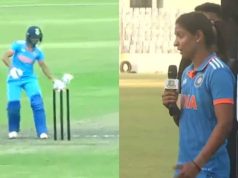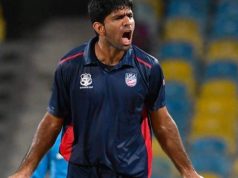Amrit Mathur has held a variety of administrative positions during his more than three decades of involvement with cricket. He served as the Indian team’s manager during their historic 1992 tour of South Africa, was a member of PILCOM, the group in charge of organising the 1996 Cricket World Cup, and was also the team’s chief operating officer and the general manager of the BCCI. As the union sports ministry’s advisor and the Sports Authority of India’s Secretary, he played a key role in developing TOPS (Target Olympic Podium Program), the program’s centrepiece for assisting elite athletes. In his book, Pitchside, My Life in Indian Cricket, Mathur shares his deep understanding of the game, its players, and its historical moments.
An example:
Sunny Gavaskar is a key figure in two of Indian cricket’s numerous mysteries.
One: In his final Test innings, while batting at 96 in the Bangalore Test against Pakistan in 1986, was he really out caught bat-pad? Two: Why did he make his retirement announcement in 1987 at Lord’s in London?
Gavaskar has restrained himself and is keeping quiet. I have some background masala to provide, but he wants the suspense to continue. When he issued handwritten invitations to friends for dinner at the Taj West End hotel on the last day of the performance in Bangalore, we already knew he wouldn’t play there again. We considered this to be a pivotal event in cricket history—a giant retiring after a remarkable career.
That evening in Bangalore, Sunny remained silent and chose to press pause rather than press the escape button. Until the following summer, when he chose to lay his bat aside after scoring 188 at Lord’s in the MCC bicentennial game, a century he had failed to reach on four prior visits to England.
I waited in line for a long time to acquire Gavaskar’s signature when he visited the Feroz Shah Kotla stadium for a charity game following his successful tour of the West Indies in 1971. Years later, I ran into him in Chennai when my friend Arun Lal made his Test debut during the Sri Lanka Test. When the game was in progress, he was reading a book while sitting in the players’ area outside the Indian dressing room. After Arun introduced us, I asked him on the spur of the moment if he would mind answering a few questions for an article I was working on. I was shocked when he replied “yes” and put the book down. I received a unique.
He wrote me a letter after I gave him an invitation for my wedding in which he made the observation that “from now on you will look at other girls and feel horrible.” I became his Delhi reporter a few years later, when he was editing Indian Cricketer, Aajkal’s English monthly magazine.
Gavaskar is just as productive and aggressive with the pen as he was with the bat. He wrote his columns by hand, sometimes in a busy dressing room, and was remarkably able to tune out all outside noise and concentrate on the task at hand. To silence the buzz of chirping fielders and the deafening stadium noise, he batted in the centre. But he never wrote or read anything while driving since he was concerned about keeping his 6/6 vision.
Similar to Bishan Bedi’s silky-smooth motion, Gavaskar made the forward defensive seem cool. It was absolute perfection. His approach, a synthesis of art, science, mathematics, and physics, allowed him to make what Dravid refers to as “difficult runs” against frighteningly quick bowling. He gained the respect of his colleagues as well as rival batsmen and bowlers like Viv Richards and Imran Khan. Kapil Dev introduced him to his adolescent daughter Amiya at a social gathering. He said, with an air of respect and affection, “Meet my captain.”
Tiger Pataudi, who was the Rajesh Khanna of his era, was followed by Gavaskar as the first cricketing legend. He developed into a trailblazer who unlocked commercial doors, opened economic prospects, and monetized star cricket. He was more adept than the others at reading figures and business trends’ direction and swing.
The Professional Management Group (PMG), Sunny’s business initiative, served as cricket’s one-stop shop, providing everything from television content to newspaper articles to celebrity management to events and sponsorships. Mr. Scindia insisted that the Railways host the national hockey championship at the brand-new Astro Turf in Gwalior. He recruited a business partner and sent a young executive named Harsha Bhogle to oversee the event.
It is commonly known that he has incredible attention skills and an unwavering drive to succeed. His memory is sharper than an elephant’s, which is something that is less generally known. He waited until Shashi Tharoor had finished shaking hands and exchanging pleasantries before casually slipping in an arm ball and reminding Shashi of a cover story he had written for the Illustrated Weekly many years prior, in which he had referred to Gavaskar as the worst captain to have ever led India. Sunny led the Indian cricket team to a remarkable victory at the World Championship in Australia not long after that story was written. Gavaskar was caught and bowled by Tharoor!








